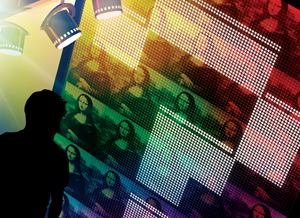The Getty Conservation Institute has teamed up with the Georgia O’Keeffe Museum for its first demonstration project, a new light filter for gallery luminaires. This filter was developed as a result of accelerated light-exposure experiments in side-by-side exposure booths—one outfitted with UV-filtered MR16 lamps, and one with thin-film filters developed at the University of Texas El Paso. Many colorants faded at slower rates under the filters. |
Jim Druzik, senior scientist at the GCI, discusses the institute’s museum lighting research and the demonstration project set up at the Georgia O’Keeffe Museum. To see the video, click here. |
Q+A with Dale Kronkright, head of conservation, Georgia O’Keeffe Museum Recent discussion in both the museum and the lighting worlds as to whether or not LEDs are suitable for museum-lighting applications, particularly the illumination of objects and artworks, has been spurred on by a letter written by Dale Kronkright, head of conservation at the Georgia O’Keeffe Museum in Santa Fe, N.M. In his March 30, 2010, letter, sent to the Green Task Force of the American Institute for Conservation (AIC) of Artistic and Historic Works, he urges caution when considering LED light sources for light-sensitive materials. ARCHITECTURAL LIGHTING editor Elizabeth Donoff spoke with Kronkright regarding his concerns and the buzz that this letter has generated.
Why did you write the letter?
I wanted to put down my thoughts on where we were clear on the issues regarding damage to light-sensitive materials and where there were still unresolved issues. The letter was written to urge caution before just accepting this new technology.
What are the differences between incandescent sources and LEDs that should be of concern for those working in museum lighting?
LEDs are a discontinuous light source and have larger light outputs than fluorescent. The things to keep in mind are, one, the electromagnetic spectrum. Artworks reflect light, and via the spectrum it’s how we see the colors of the artwork. The second thing to consider is the wavelengths that are absorbed. These are the initiators of deterioration. The relationship to the color of the spectrum and the absorption spectra is what you have to be thinking about in terms of conservation issues.
Are LEDs an option for museum lighting?
I am not against LEDs; I love the promise of them, but for museum lighting they are not a slam-dunk right now. Instead, we need to push manufacturers to better understand the conservation issues we are dealing with and help to drive the technology so that there will come a time when we can use LED sources in museum lighting that will address the spectrum issues.
